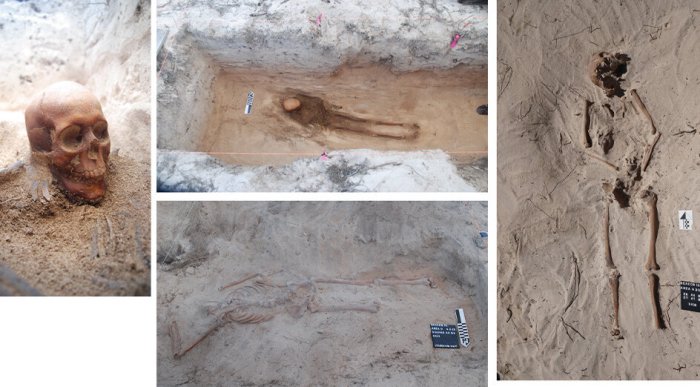Conny Waters – AncientPages.com – “The loss of the Dutch East India Company ship Batavia in 1629 on the Houtman Abrolhos off the west coast of Australia and subsequent mutiny is one of the most dramatic events in the history of European encounters with Australia, and was widely popularized in 17th-century publications,” write researchers in their paper.

Beacon Island burials discovered between 2015 and 2018. Credit: University of Western Australia
An archaeological research project spanning five years has shed new light on a tragic chapter in Australian history, revealing a wealth of evidence that has helped to unravel the haunting tale of the Batavia maritime disaster and subsequent mutiny.
Findings from the international research team, led by archaeologists from The University of Western Australia and the Western Australian Museum and published in Historical Archaeology, include the unearthing of single and multiple graves, as well as evidence of survivors’ resistance to mutineers.
The Dutch East India Company’s ill-fated ship Batavia, lost in 1629 off WA’s Abrolhos Islands, has captivated historians and adventurers for centuries.
Lead author Professor Alistair Paterson, from UWA’s School of Social Sciences and the Oceans Insтιтute, said artifacts and gravesites tell a tale of survival, resistance and grim consequences faced by those involved.
“Through meticulous analysis, we’ve discovered the remains of 12 victims, interred in both individual and mᴀss graves, as well as evidence of a fierce struggle between survivors and a group of mutineers, and remnants of a possible gallows site where justice was served,” Professor Paterson said, in a press release.
He said the finds provide invaluable insight into the survival landscape encountered by some of the earliest Europeans to visit Australia and have expanded focus beyond the Batavia wreck itself.
“In addition to underwater findings, what we’ve uncovered on land has contributed to our understanding of the behavioral responses of survivors, including their initial movement from the wreck to nearby islands, the struggles they faced, and the shifting power dynamics among mutineers and survivors,” he said.
“The excavation of human remains reveals insights into the treatment and burial practices of victims. Notably, centrally located graves on Beacon Island suggest a functioning graveyard, potentially representing victims from the early days following the wreck.
“Other islands within the vicinity, such as Long (Seals) Island and West Wallabi Island, provide evidence of makeshift weapons, the presence of resistance factions, and structures ᴀssociated with the survivors.
“The landscape on Long Island contains a concentration of iron fastenings believed to be the gallows site where mutineers were executed, reflecting the company’s attempt to establish order.”
Future research in a new ARC Project “Mobilizing Dutch East India Company collections for new global stories” involves further forensic analysis of human remains, including physical ᴀssessment, stable-isotope technology and DNA studies and new historical research.
Paper
Written by Conny Waters – AncientPages.com Staff Writer





